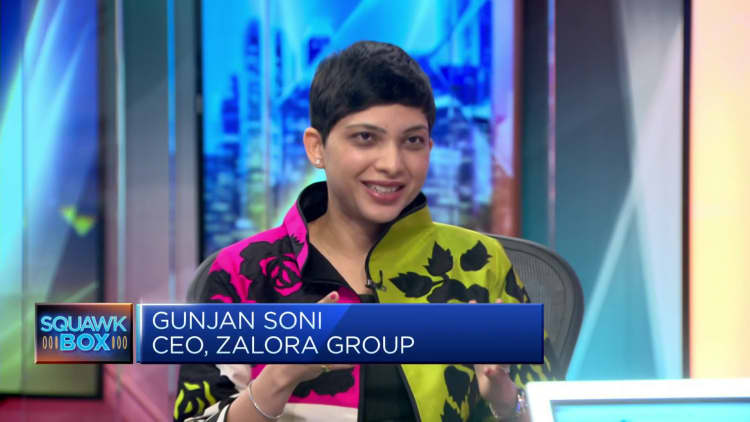VIENNA, AUSTRIA – NOVEMBER 25, 2022: Karin Teigl is seen wearing Hermès yellow leather mini Kelly, Baum & Pferdgarten green leather jacket, Lumina beige cropped turtleneck sweater and vintage checked green yellow pants.
Jeremy Moeller | Getty Images
Quiet luxury was one of last year’s biggest viral fashion trends on social media — but unlike other short-lived fads on TikTok or Instagram, this one has made its way into investor portfolios and shown actual returns.
So what is “quiet luxury”?
The trend revolves around understated, subtle displays of opulence and popular shows like HBO series “Succession” have also played a part in boosting its popularity.
Gone are the days of loud, flashy displays of wealth in fashion — it is now all about subtlety and minimalism.
But the trend has not only gained traction in the fashion world, even investors are starting to take notice.
Brand boost
Luxury stocks have long been regarded by some as an effective hedge against inflation. This is largely to do with the segment’s high pricing that seldom deters its affluent customer base and much higher margins than many other consumer discretionary products, such as televisions or phones.
In essence, the segment’s fundamentals have not changed drastically over decades but as the quiet luxury movement takes hold, investors are starting to cherry pick names that largely check those boxes.
Some of the companies and their labels have encapsulated what experts say is the essence of quiet luxury, with data from Southeast Asia’s largest lender, DBS Bank, showing that such names have been able to outperform their “loud” counterparts in 2023.
Some of the top companies that have benefited from this new wave are Hermes, Prada-owned Miu Miu, Brunello Cucinelli, Compagnie Financière Richemont and Swatch Group, according to DBS.
Quiet Luxury’s outperformance over Loud Luxury in 2023.
DBS
“With the quiet luxury movement underscoring growing consumer preference for subtlety in luxury consumption, companies that focus on understated elegance and timeless quality will resonate with consumers, benefitting from this trend,” said Hou Wey Fook, chief investment officer of DBS Bank.
“Hence, in 2023, quiet luxury companies notably outperformed their loud peers by 23% points. We expect this ongoing shift in the industry’s dynamics will help sustain this bifurcation in performance.”
According to DBS, a company fall under its categorization of “quiet luxury” if it’s understated and focused on high quality, while maintaining exclusivity and scarcity.
Some of the bank’s top picks include Hermes, Moncler, LVMH Moët Hennessy Louis Vuitton, Richemont, Swatch, Brunello Cucinelli and Ermenegildo Zegna.
Go long on quiet luxury
Unlike viral trends that come and go, investors are looking at these companies with a much longer term view.
“There’s this element of: ‘I’m tired of all the big logo stuff,'” said Markus Hansen, portfolio manager at Vontobel Quality Growth Boutique, noting that consumers and investors now want a higher quality product.
“It comes back to the heritage of these houses, which are the ones that are the most successful … and what we invest in are the ones that take a very long term view,” he told CNBC.

In Asia-Pacific, the demand narrative for luxury goods could be shifting due to China’s uneven post-pandemic recovery and lackluster domestic demand.
Though Chinese consumers’ appetite for luxury goods may not have completely dried up, luxury brands are broadening their horizons to cater to other big markets in Asia.
In Asia, mature markets like South Korea and Japan are seeing growing demand for luxury goods, Hansen said.
He added: “India is the last big market, not just the population, but in terms of the growing wealth of the population.”
A recent Goldman Sachs report predicted around 100 million people in India will become “affluent” by 2027 — defined by the U.S. investment bank as those earning an annual income exceeding $10,000. Currently, 60 million people in the world’s fifth-largest economy earn more than $10,000, the report said.
Loud luxury not in vogue
Quiet luxury stocks were bumped up in portfolios last year, pushing down brands that were considered too “loud.”
As a result, Kering-owned Gucci & Burberry were pushed lower in global rankings of luxury stocks, Bank of America Securities research showed.
“We believe that throughout the year brands should focus back on fashion content and newness in order to re-engage customers and drive traffic,” said BofA research analyst Ashley Wallace, noting that companies that are geared toward quiet luxury are better positioned this year.
BofA said it preferred companies like LVMH and Hermes over Gucci-owner Kering and Burberry.

